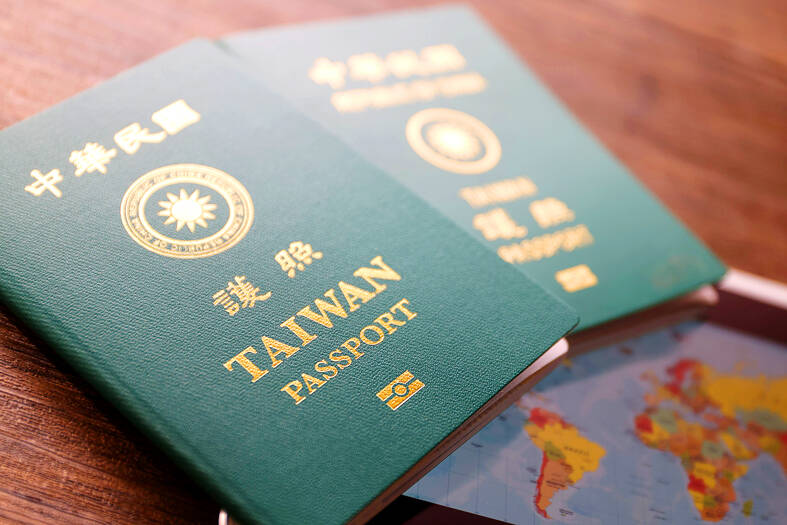A Taiwan passport enables its holder to enter 141 destinations visa-free, ranking 33rd among 199 countries and regions on this year’s Henley Passport Index.
Taiwan shared the same ranking as Peru, a slight improvement from 35th place last year, the index released yesterday by citizenship consultancy firm Henley & Partners showed.
Since the company started releasing annual rankings 19 years ago, Taiwan has climbed from 55th to 33rd place.

Photo: CNA
Taiwan’s ranking dropped to its lowest point, at 69th, in 2010, and reached its highest position, 24th, in 2014.
However, Taiwan’s position has stayed relatively steady at around 30th place since 2015, the report said.
Singapore rose from second to first place in this year’s rankings, with visa-free access to 195 destinations. The city-state has ranked first or second annually since 2018.
Following Singapore were France, Germany, Italy, Japan and Spain, tied in second place with visa-free access to 192 destinations each.
Austria, Finland, Ireland, Luxembourg, the Netherlands, South Korea and Sweden tied at third place, with 191 countries or regions not requiring holders to apply for visas in advance.
Next up were Belgium, Denmark, New Zealand, Norway, Switzerland and the UK, tied in fourth place with visa-free access to 190 destinations.
Placing fifth were Australia and Portugal, whose passport holders can travel to 189 destinations visa-free.
Hong Kong ranked 18th with visa-exemptions to 170 destinations, while China placed 59th with 85 countries and regions.
The Henley Passport Index rankings are calculated based on how many countries or areas a passport allows its holder to enter with no visa required.
The index compares 199 passports’ access to 227 travel destinations based on exclusive data from the International Air Transport Association, “the largest, most accurate travel information database,” according to Henley & Partners.
Based in London, Henley & Partners is “the global leader in residence and citizenship by investment,” a statement on its official Web site says.

US climber Alex Honnold is to attempt to scale Taipei 101 without a rope and harness in a live Netflix special on Jan. 24, the streaming platform announced on Wednesday. Accounting for the time difference, the two-hour broadcast of Honnold’s climb, called Skyscraper Live, is to air on Jan. 23 in the US, Netflix said in a statement. Honnold, 40, was the first person ever to free solo climb the 900m El Capitan rock formation in Yosemite National Park — a feat that was recorded and later made into the 2018 documentary film Free Solo. Netflix previewed Skyscraper Live in October, after videos

Starting on Jan. 1, YouBike riders must have insurance to use the service, and a six-month trial of NT$5 coupons under certain conditions would be implemented to balance bike shortages, a joint statement from transportation departments across Taipei, New Taipei City and Taoyuan announced yesterday. The rental bike system operator said that coupons would be offered to riders to rent bikes from full stations, for riders who take out an electric-assisted bike from a full station, and for riders who return a bike to an empty station. All riders with YouBike accounts are automatically eligible for the program, and each membership account

A classified Pentagon-produced, multiyear assessment — the Overmatch brief — highlighted unreported Chinese capabilities to destroy US military assets and identified US supply chain choke points, painting a disturbing picture of waning US military might, a New York Times editorial published on Monday said. US Secretary of Defense Pete Hegseth’s comments in November last year that “we lose every time” in Pentagon-conducted war games pitting the US against China further highlighted the uncertainty about the US’ capability to intervene in the event of a Chinese invasion of Taiwan. “It shows the Pentagon’s overreliance on expensive, vulnerable weapons as adversaries field cheap, technologically

NUMBERs IMBALANCE: More than 4 million Taiwanese have visited China this year, while only about half a million Chinese have visited here Beijing has yet to respond to Taiwan’s requests for negotiation over matters related to the recovery of cross-strait tourism, the Tourism Administration said yesterday. Taiwan’s tourism authority issued the statement after Chinese-language daily the China Times reported yesterday that the government’s policy of banning group tours to China does not stop Taiwanese from visiting the country. As of October, more than 4.2 million had traveled to China this year, exceeding last year. Beijing estimated the number of Taiwanese tourists in China could reach 4.5 million this year. By contrast, only 500,000 Chinese tourists are expected in Taiwan, the report said. The report